Predicting Environmental Hazard Impact on Sri Lankan Agri Loans
VerifiedAdded on 2023/06/03
|15
|2896
|152
Project
AI Summary
This project investigates the impact of environmental hazards on agricultural loan loss experience in large banks in Sri Lanka, utilizing historical data from the past ten years. The research explores the effectiveness of regulatory interventions, agricultural insurance, innovative product development, knowledge management, and global engagements in predicting and mitigating loan losses. The study employs both primary and secondary research methods, including statistical analysis of loan loss data and interviews to gather insights into the relationship between environmental factors and agricultural productivity. The project's objectives include understanding the role of regulatory interventions, predicting the impact of environmental hazards, assessing the usefulness of agricultural insurance, and evaluating the contribution of knowledge management and global engagements. The methodology involves descriptive and inferential statistics, regression models, and analysis of variance to formulate a predictive formula for annual agricultural loan loss. The project's deliverables include a detailed research design, data collection and analysis, and the publication of the interpreted results, aiming to provide valuable insights for financial institutions in managing agricultural loan risk.
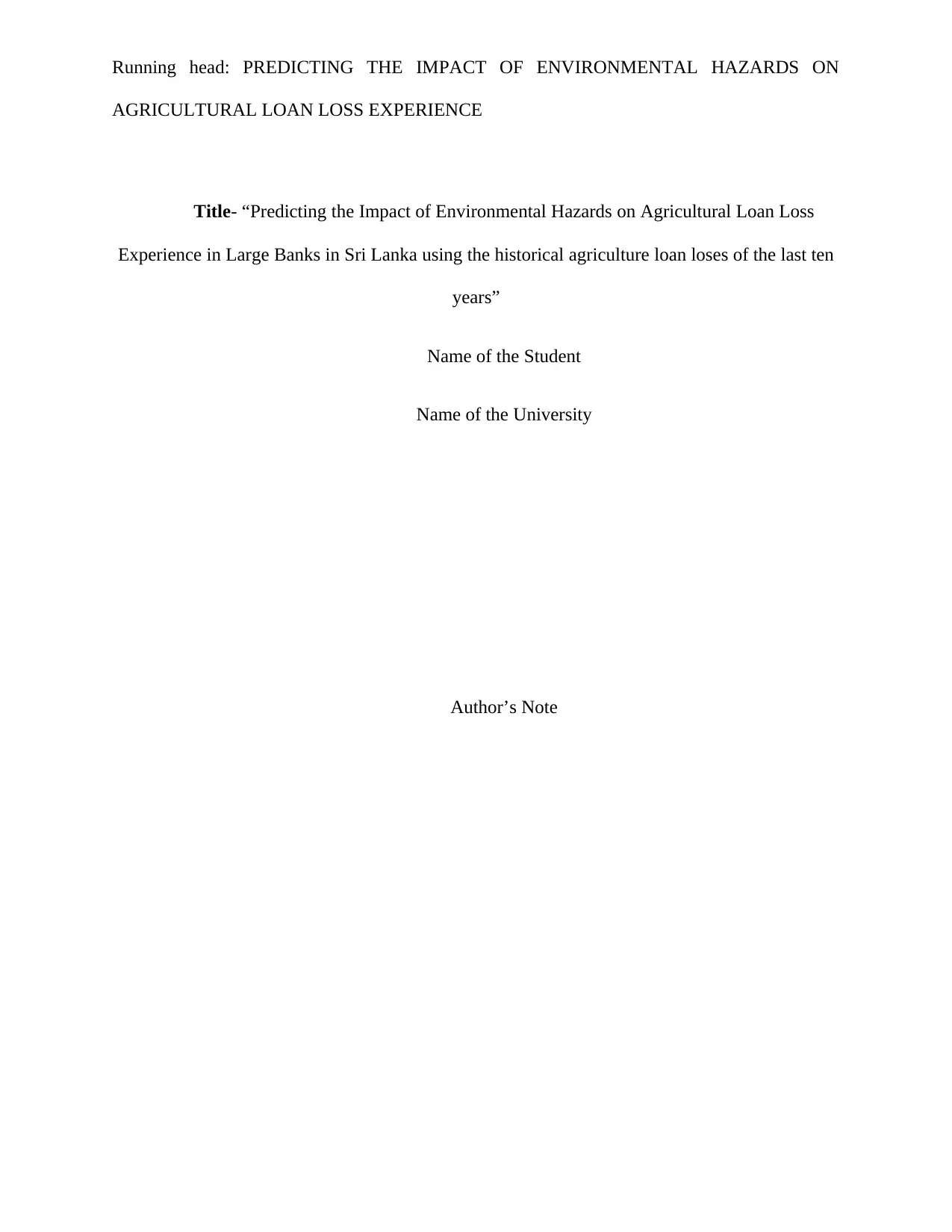
Running head: PREDICTING THE IMPACT OF ENVIRONMENTAL HAZARDS ON
AGRICULTURAL LOAN LOSS EXPERIENCE
Title- “Predicting the Impact of Environmental Hazards on Agricultural Loan Loss
Experience in Large Banks in Sri Lanka using the historical agriculture loan loses of the last ten
years”
Name of the Student
Name of the University
Author’s Note
AGRICULTURAL LOAN LOSS EXPERIENCE
Title- “Predicting the Impact of Environmental Hazards on Agricultural Loan Loss
Experience in Large Banks in Sri Lanka using the historical agriculture loan loses of the last ten
years”
Name of the Student
Name of the University
Author’s Note
Paraphrase This Document
Need a fresh take? Get an instant paraphrase of this document with our AI Paraphraser
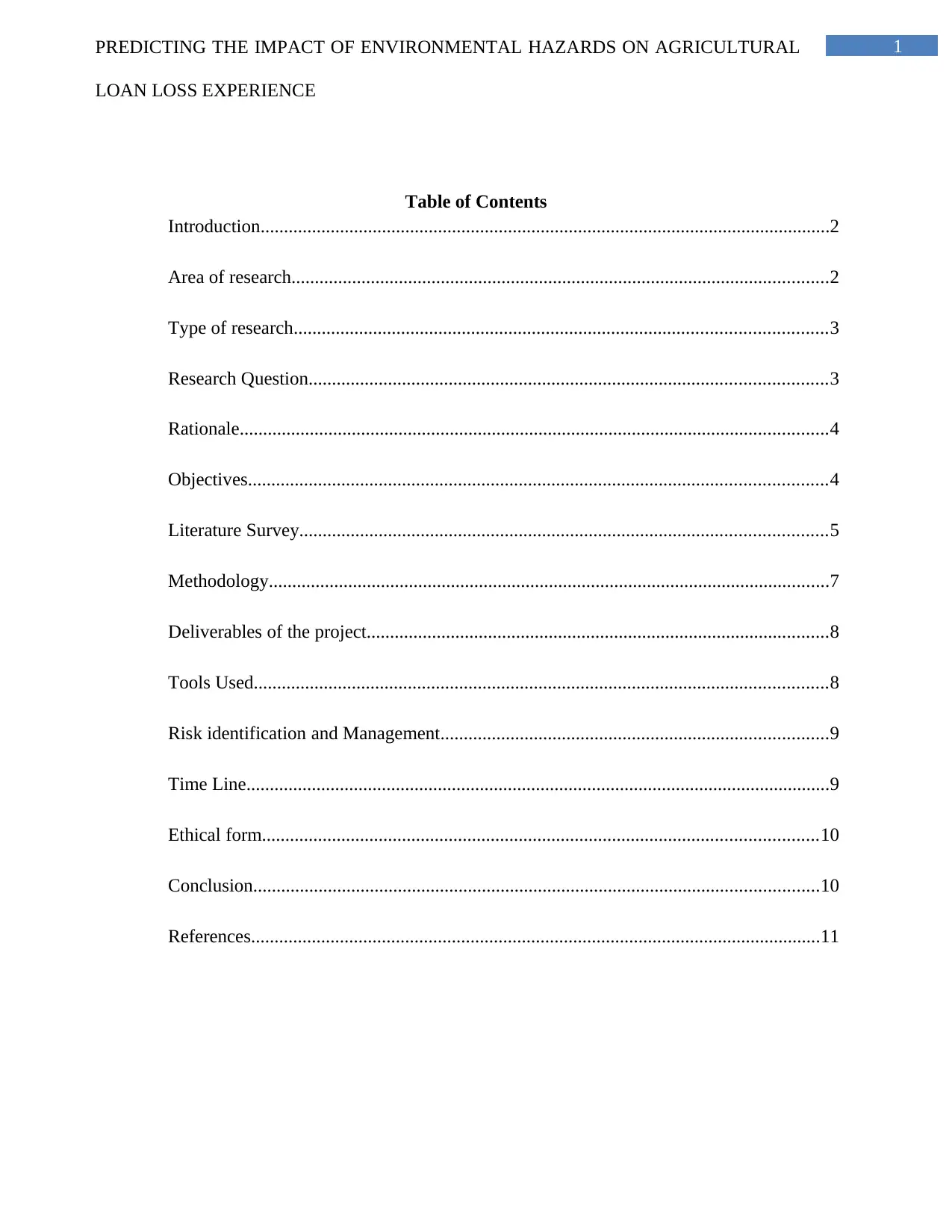
1PREDICTING THE IMPACT OF ENVIRONMENTAL HAZARDS ON AGRICULTURAL
LOAN LOSS EXPERIENCE
Table of Contents
Introduction..........................................................................................................................2
Area of research...................................................................................................................2
Type of research..................................................................................................................3
Research Question...............................................................................................................3
Rationale..............................................................................................................................4
Objectives............................................................................................................................4
Literature Survey.................................................................................................................5
Methodology........................................................................................................................7
Deliverables of the project...................................................................................................8
Tools Used...........................................................................................................................8
Risk identification and Management...................................................................................9
Time Line.............................................................................................................................9
Ethical form.......................................................................................................................10
Conclusion.........................................................................................................................10
References..........................................................................................................................11
LOAN LOSS EXPERIENCE
Table of Contents
Introduction..........................................................................................................................2
Area of research...................................................................................................................2
Type of research..................................................................................................................3
Research Question...............................................................................................................3
Rationale..............................................................................................................................4
Objectives............................................................................................................................4
Literature Survey.................................................................................................................5
Methodology........................................................................................................................7
Deliverables of the project...................................................................................................8
Tools Used...........................................................................................................................8
Risk identification and Management...................................................................................9
Time Line.............................................................................................................................9
Ethical form.......................................................................................................................10
Conclusion.........................................................................................................................10
References..........................................................................................................................11
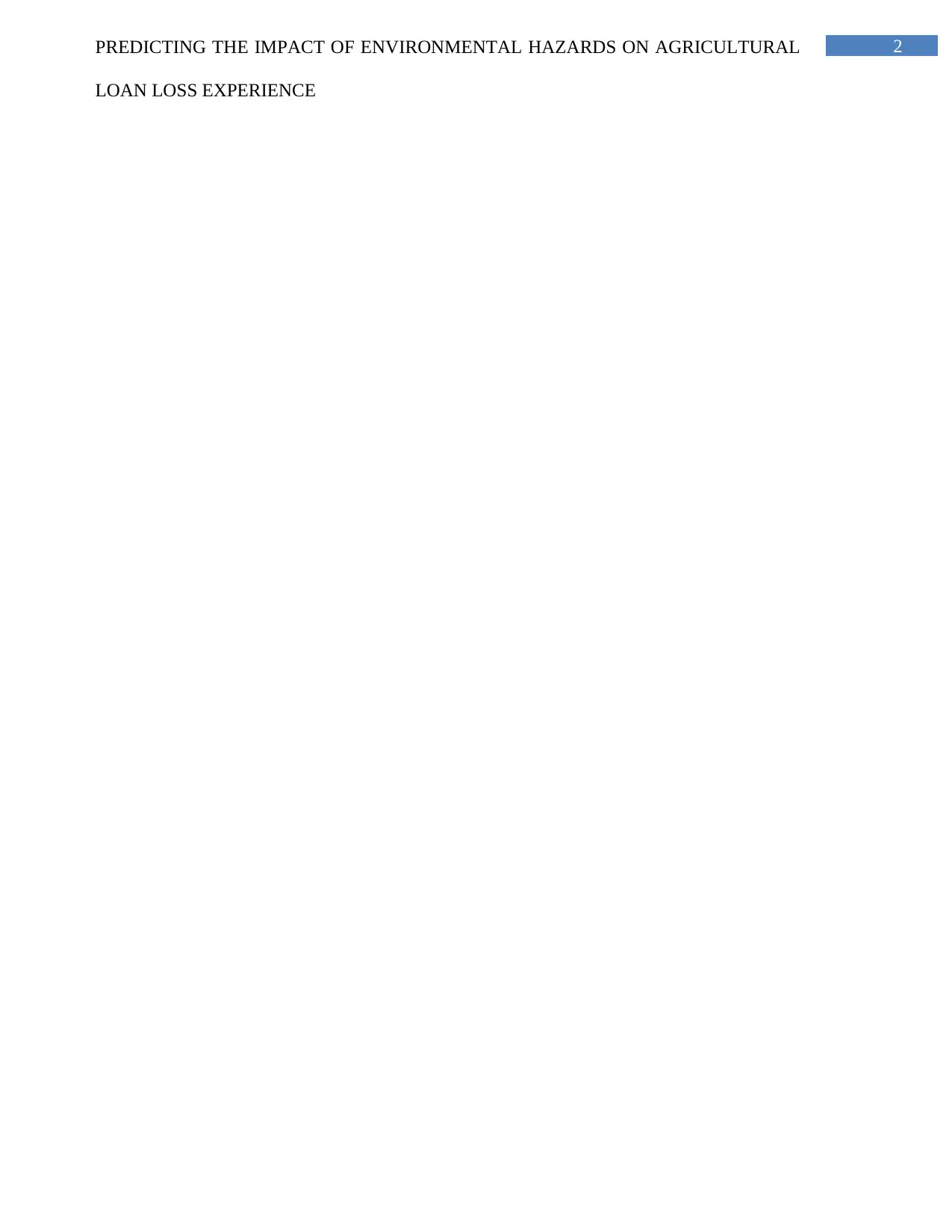
2PREDICTING THE IMPACT OF ENVIRONMENTAL HAZARDS ON AGRICULTURAL
LOAN LOSS EXPERIENCE
LOAN LOSS EXPERIENCE
⊘ This is a preview!⊘
Do you want full access?
Subscribe today to unlock all pages.

Trusted by 1+ million students worldwide
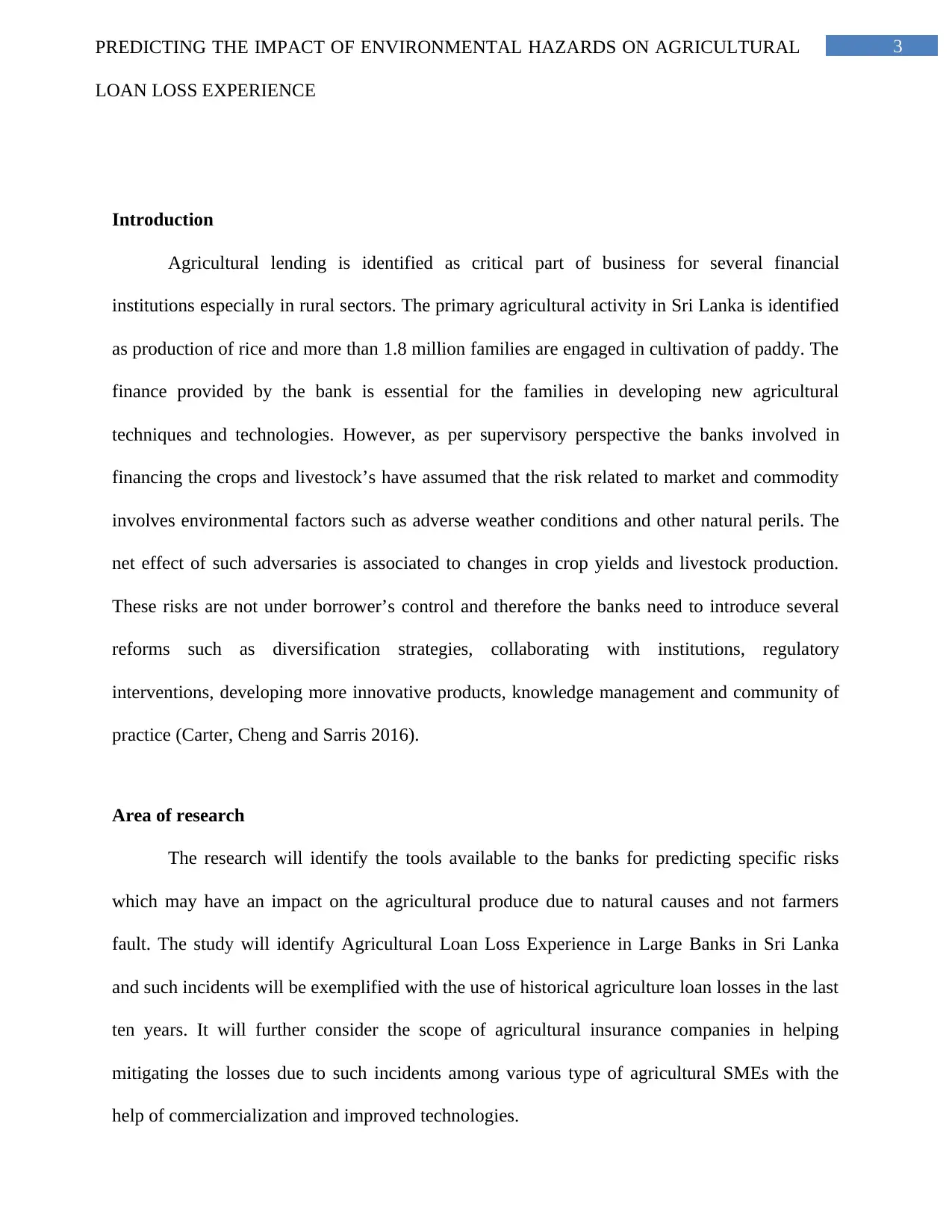
3PREDICTING THE IMPACT OF ENVIRONMENTAL HAZARDS ON AGRICULTURAL
LOAN LOSS EXPERIENCE
Introduction
Agricultural lending is identified as critical part of business for several financial
institutions especially in rural sectors. The primary agricultural activity in Sri Lanka is identified
as production of rice and more than 1.8 million families are engaged in cultivation of paddy. The
finance provided by the bank is essential for the families in developing new agricultural
techniques and technologies. However, as per supervisory perspective the banks involved in
financing the crops and livestock’s have assumed that the risk related to market and commodity
involves environmental factors such as adverse weather conditions and other natural perils. The
net effect of such adversaries is associated to changes in crop yields and livestock production.
These risks are not under borrower’s control and therefore the banks need to introduce several
reforms such as diversification strategies, collaborating with institutions, regulatory
interventions, developing more innovative products, knowledge management and community of
practice (Carter, Cheng and Sarris 2016).
Area of research
The research will identify the tools available to the banks for predicting specific risks
which may have an impact on the agricultural produce due to natural causes and not farmers
fault. The study will identify Agricultural Loan Loss Experience in Large Banks in Sri Lanka
and such incidents will be exemplified with the use of historical agriculture loan losses in the last
ten years. It will further consider the scope of agricultural insurance companies in helping
mitigating the losses due to such incidents among various type of agricultural SMEs with the
help of commercialization and improved technologies.
LOAN LOSS EXPERIENCE
Introduction
Agricultural lending is identified as critical part of business for several financial
institutions especially in rural sectors. The primary agricultural activity in Sri Lanka is identified
as production of rice and more than 1.8 million families are engaged in cultivation of paddy. The
finance provided by the bank is essential for the families in developing new agricultural
techniques and technologies. However, as per supervisory perspective the banks involved in
financing the crops and livestock’s have assumed that the risk related to market and commodity
involves environmental factors such as adverse weather conditions and other natural perils. The
net effect of such adversaries is associated to changes in crop yields and livestock production.
These risks are not under borrower’s control and therefore the banks need to introduce several
reforms such as diversification strategies, collaborating with institutions, regulatory
interventions, developing more innovative products, knowledge management and community of
practice (Carter, Cheng and Sarris 2016).
Area of research
The research will identify the tools available to the banks for predicting specific risks
which may have an impact on the agricultural produce due to natural causes and not farmers
fault. The study will identify Agricultural Loan Loss Experience in Large Banks in Sri Lanka
and such incidents will be exemplified with the use of historical agriculture loan losses in the last
ten years. It will further consider the scope of agricultural insurance companies in helping
mitigating the losses due to such incidents among various type of agricultural SMEs with the
help of commercialization and improved technologies.
Paraphrase This Document
Need a fresh take? Get an instant paraphrase of this document with our AI Paraphraser
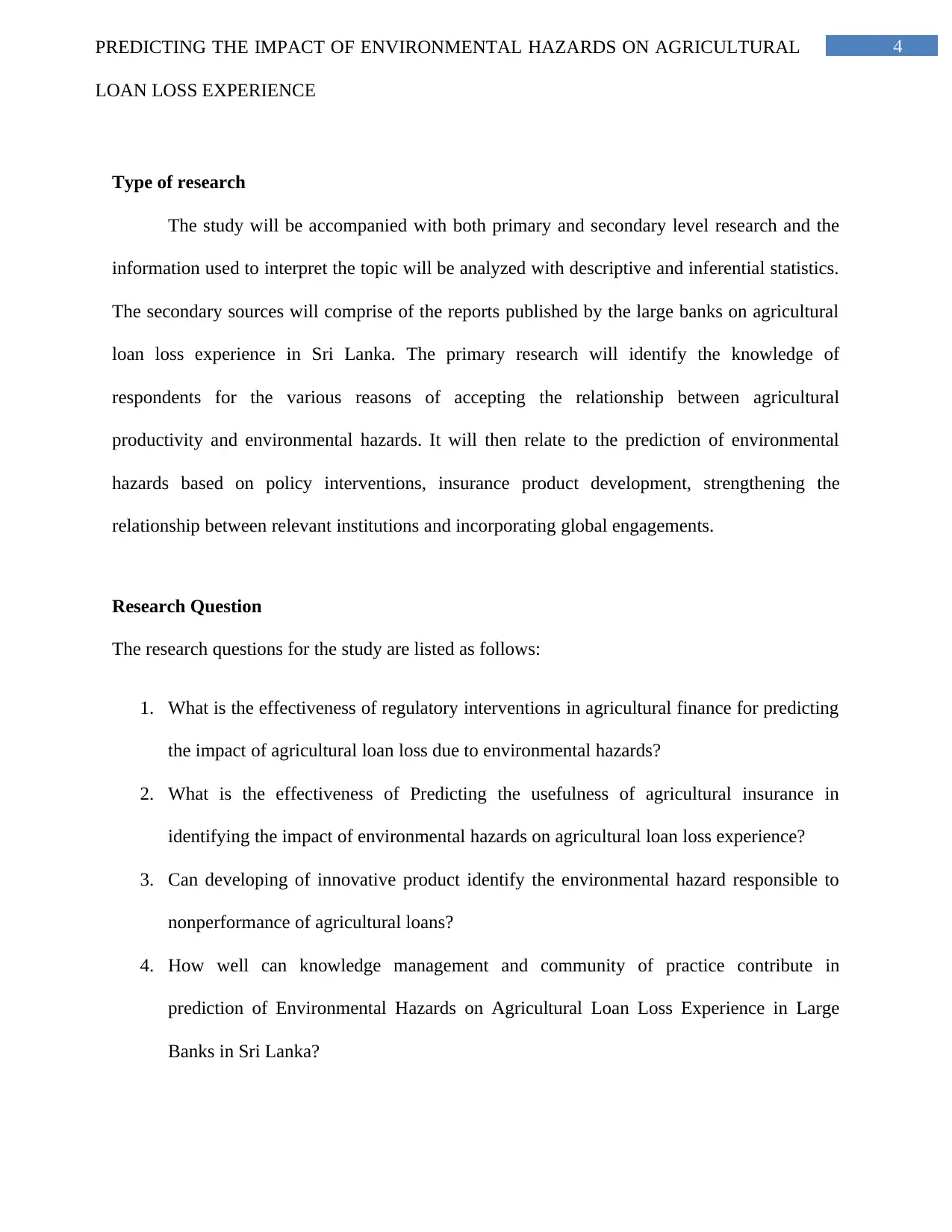
4PREDICTING THE IMPACT OF ENVIRONMENTAL HAZARDS ON AGRICULTURAL
LOAN LOSS EXPERIENCE
Type of research
The study will be accompanied with both primary and secondary level research and the
information used to interpret the topic will be analyzed with descriptive and inferential statistics.
The secondary sources will comprise of the reports published by the large banks on agricultural
loan loss experience in Sri Lanka. The primary research will identify the knowledge of
respondents for the various reasons of accepting the relationship between agricultural
productivity and environmental hazards. It will then relate to the prediction of environmental
hazards based on policy interventions, insurance product development, strengthening the
relationship between relevant institutions and incorporating global engagements.
Research Question
The research questions for the study are listed as follows:
1. What is the effectiveness of regulatory interventions in agricultural finance for predicting
the impact of agricultural loan loss due to environmental hazards?
2. What is the effectiveness of Predicting the usefulness of agricultural insurance in
identifying the impact of environmental hazards on agricultural loan loss experience?
3. Can developing of innovative product identify the environmental hazard responsible to
nonperformance of agricultural loans?
4. How well can knowledge management and community of practice contribute in
prediction of Environmental Hazards on Agricultural Loan Loss Experience in Large
Banks in Sri Lanka?
LOAN LOSS EXPERIENCE
Type of research
The study will be accompanied with both primary and secondary level research and the
information used to interpret the topic will be analyzed with descriptive and inferential statistics.
The secondary sources will comprise of the reports published by the large banks on agricultural
loan loss experience in Sri Lanka. The primary research will identify the knowledge of
respondents for the various reasons of accepting the relationship between agricultural
productivity and environmental hazards. It will then relate to the prediction of environmental
hazards based on policy interventions, insurance product development, strengthening the
relationship between relevant institutions and incorporating global engagements.
Research Question
The research questions for the study are listed as follows:
1. What is the effectiveness of regulatory interventions in agricultural finance for predicting
the impact of agricultural loan loss due to environmental hazards?
2. What is the effectiveness of Predicting the usefulness of agricultural insurance in
identifying the impact of environmental hazards on agricultural loan loss experience?
3. Can developing of innovative product identify the environmental hazard responsible to
nonperformance of agricultural loans?
4. How well can knowledge management and community of practice contribute in
prediction of Environmental Hazards on Agricultural Loan Loss Experience in Large
Banks in Sri Lanka?
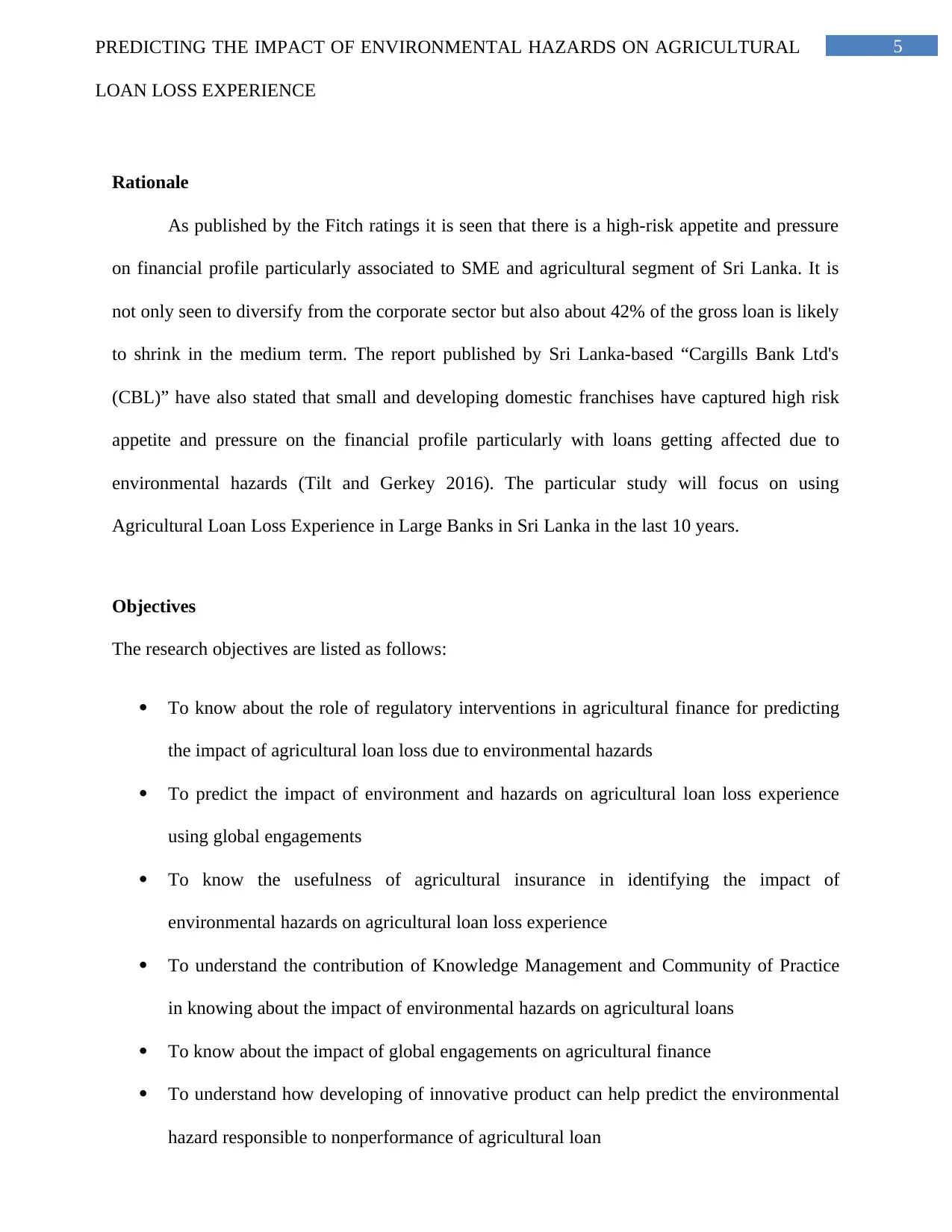
5PREDICTING THE IMPACT OF ENVIRONMENTAL HAZARDS ON AGRICULTURAL
LOAN LOSS EXPERIENCE
Rationale
As published by the Fitch ratings it is seen that there is a high-risk appetite and pressure
on financial profile particularly associated to SME and agricultural segment of Sri Lanka. It is
not only seen to diversify from the corporate sector but also about 42% of the gross loan is likely
to shrink in the medium term. The report published by Sri Lanka-based “Cargills Bank Ltd's
(CBL)” have also stated that small and developing domestic franchises have captured high risk
appetite and pressure on the financial profile particularly with loans getting affected due to
environmental hazards (Tilt and Gerkey 2016). The particular study will focus on using
Agricultural Loan Loss Experience in Large Banks in Sri Lanka in the last 10 years.
Objectives
The research objectives are listed as follows:
To know about the role of regulatory interventions in agricultural finance for predicting
the impact of agricultural loan loss due to environmental hazards
To predict the impact of environment and hazards on agricultural loan loss experience
using global engagements
To know the usefulness of agricultural insurance in identifying the impact of
environmental hazards on agricultural loan loss experience
To understand the contribution of Knowledge Management and Community of Practice
in knowing about the impact of environmental hazards on agricultural loans
To know about the impact of global engagements on agricultural finance
To understand how developing of innovative product can help predict the environmental
hazard responsible to nonperformance of agricultural loan
LOAN LOSS EXPERIENCE
Rationale
As published by the Fitch ratings it is seen that there is a high-risk appetite and pressure
on financial profile particularly associated to SME and agricultural segment of Sri Lanka. It is
not only seen to diversify from the corporate sector but also about 42% of the gross loan is likely
to shrink in the medium term. The report published by Sri Lanka-based “Cargills Bank Ltd's
(CBL)” have also stated that small and developing domestic franchises have captured high risk
appetite and pressure on the financial profile particularly with loans getting affected due to
environmental hazards (Tilt and Gerkey 2016). The particular study will focus on using
Agricultural Loan Loss Experience in Large Banks in Sri Lanka in the last 10 years.
Objectives
The research objectives are listed as follows:
To know about the role of regulatory interventions in agricultural finance for predicting
the impact of agricultural loan loss due to environmental hazards
To predict the impact of environment and hazards on agricultural loan loss experience
using global engagements
To know the usefulness of agricultural insurance in identifying the impact of
environmental hazards on agricultural loan loss experience
To understand the contribution of Knowledge Management and Community of Practice
in knowing about the impact of environmental hazards on agricultural loans
To know about the impact of global engagements on agricultural finance
To understand how developing of innovative product can help predict the environmental
hazard responsible to nonperformance of agricultural loan
⊘ This is a preview!⊘
Do you want full access?
Subscribe today to unlock all pages.

Trusted by 1+ million students worldwide
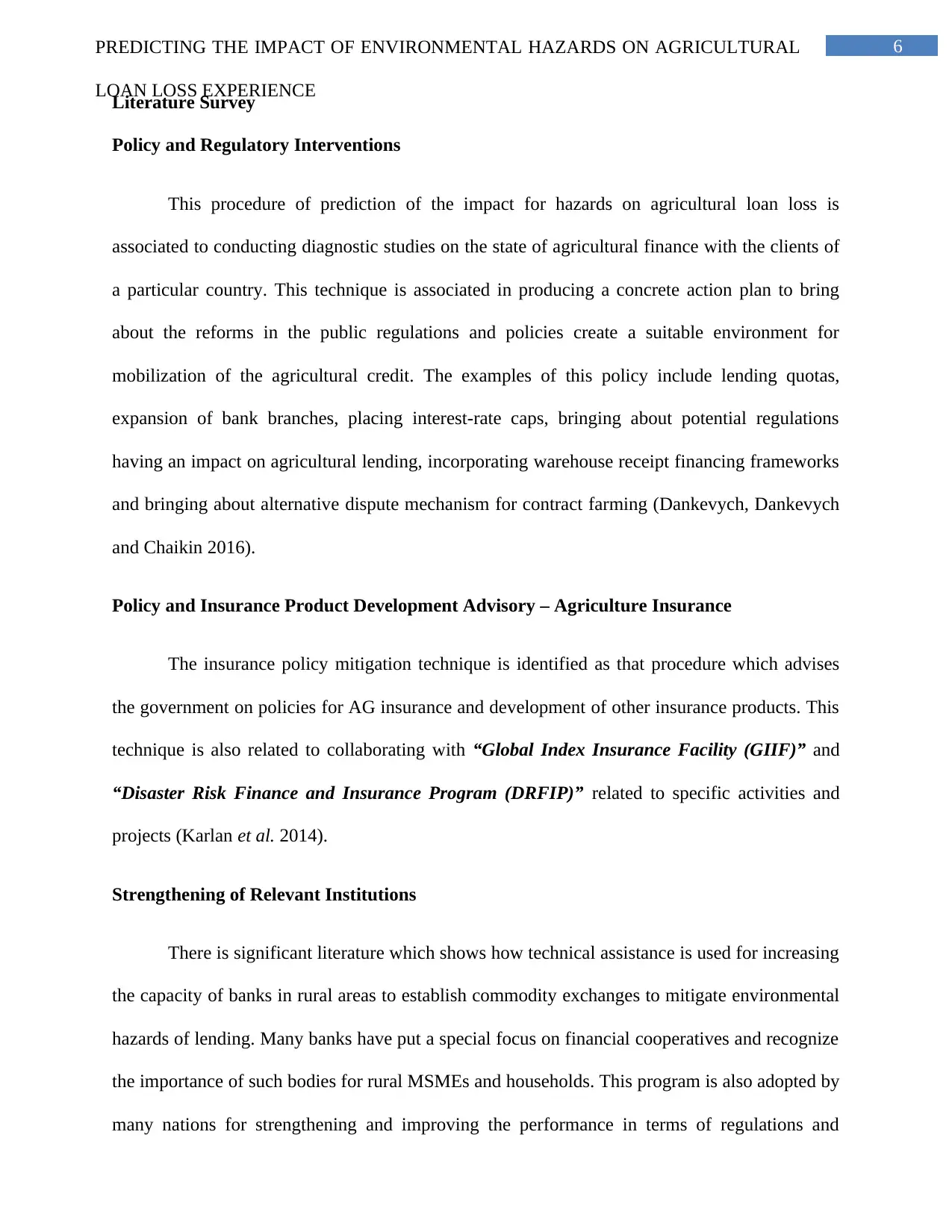
6PREDICTING THE IMPACT OF ENVIRONMENTAL HAZARDS ON AGRICULTURAL
LOAN LOSS EXPERIENCE
Literature Survey
Policy and Regulatory Interventions
This procedure of prediction of the impact for hazards on agricultural loan loss is
associated to conducting diagnostic studies on the state of agricultural finance with the clients of
a particular country. This technique is associated in producing a concrete action plan to bring
about the reforms in the public regulations and policies create a suitable environment for
mobilization of the agricultural credit. The examples of this policy include lending quotas,
expansion of bank branches, placing interest-rate caps, bringing about potential regulations
having an impact on agricultural lending, incorporating warehouse receipt financing frameworks
and bringing about alternative dispute mechanism for contract farming (Dankevych, Dankevych
and Chaikin 2016).
Policy and Insurance Product Development Advisory – Agriculture Insurance
The insurance policy mitigation technique is identified as that procedure which advises
the government on policies for AG insurance and development of other insurance products. This
technique is also related to collaborating with “Global Index Insurance Facility (GIIF)” and
“Disaster Risk Finance and Insurance Program (DRFIP)” related to specific activities and
projects (Karlan et al. 2014).
Strengthening of Relevant Institutions
There is significant literature which shows how technical assistance is used for increasing
the capacity of banks in rural areas to establish commodity exchanges to mitigate environmental
hazards of lending. Many banks have put a special focus on financial cooperatives and recognize
the importance of such bodies for rural MSMEs and households. This program is also adopted by
many nations for strengthening and improving the performance in terms of regulations and
LOAN LOSS EXPERIENCE
Literature Survey
Policy and Regulatory Interventions
This procedure of prediction of the impact for hazards on agricultural loan loss is
associated to conducting diagnostic studies on the state of agricultural finance with the clients of
a particular country. This technique is associated in producing a concrete action plan to bring
about the reforms in the public regulations and policies create a suitable environment for
mobilization of the agricultural credit. The examples of this policy include lending quotas,
expansion of bank branches, placing interest-rate caps, bringing about potential regulations
having an impact on agricultural lending, incorporating warehouse receipt financing frameworks
and bringing about alternative dispute mechanism for contract farming (Dankevych, Dankevych
and Chaikin 2016).
Policy and Insurance Product Development Advisory – Agriculture Insurance
The insurance policy mitigation technique is identified as that procedure which advises
the government on policies for AG insurance and development of other insurance products. This
technique is also related to collaborating with “Global Index Insurance Facility (GIIF)” and
“Disaster Risk Finance and Insurance Program (DRFIP)” related to specific activities and
projects (Karlan et al. 2014).
Strengthening of Relevant Institutions
There is significant literature which shows how technical assistance is used for increasing
the capacity of banks in rural areas to establish commodity exchanges to mitigate environmental
hazards of lending. Many banks have put a special focus on financial cooperatives and recognize
the importance of such bodies for rural MSMEs and households. This program is also adopted by
many nations for strengthening and improving the performance in terms of regulations and
Paraphrase This Document
Need a fresh take? Get an instant paraphrase of this document with our AI Paraphraser
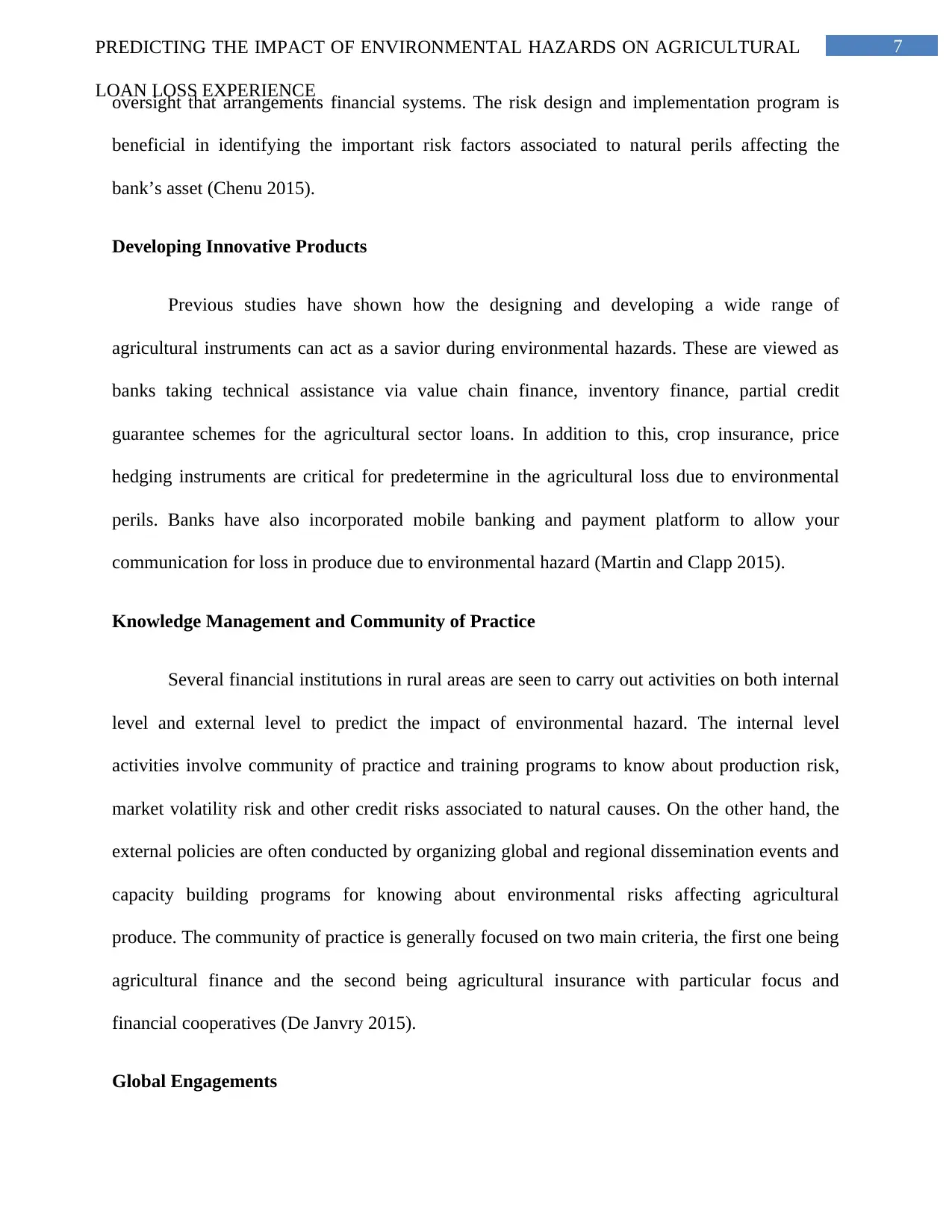
7PREDICTING THE IMPACT OF ENVIRONMENTAL HAZARDS ON AGRICULTURAL
LOAN LOSS EXPERIENCE
oversight that arrangements financial systems. The risk design and implementation program is
beneficial in identifying the important risk factors associated to natural perils affecting the
bank’s asset (Chenu 2015).
Developing Innovative Products
Previous studies have shown how the designing and developing a wide range of
agricultural instruments can act as a savior during environmental hazards. These are viewed as
banks taking technical assistance via value chain finance, inventory finance, partial credit
guarantee schemes for the agricultural sector loans. In addition to this, crop insurance, price
hedging instruments are critical for predetermine in the agricultural loss due to environmental
perils. Banks have also incorporated mobile banking and payment platform to allow your
communication for loss in produce due to environmental hazard (Martin and Clapp 2015).
Knowledge Management and Community of Practice
Several financial institutions in rural areas are seen to carry out activities on both internal
level and external level to predict the impact of environmental hazard. The internal level
activities involve community of practice and training programs to know about production risk,
market volatility risk and other credit risks associated to natural causes. On the other hand, the
external policies are often conducted by organizing global and regional dissemination events and
capacity building programs for knowing about environmental risks affecting agricultural
produce. The community of practice is generally focused on two main criteria, the first one being
agricultural finance and the second being agricultural insurance with particular focus and
financial cooperatives (De Janvry 2015).
Global Engagements
LOAN LOSS EXPERIENCE
oversight that arrangements financial systems. The risk design and implementation program is
beneficial in identifying the important risk factors associated to natural perils affecting the
bank’s asset (Chenu 2015).
Developing Innovative Products
Previous studies have shown how the designing and developing a wide range of
agricultural instruments can act as a savior during environmental hazards. These are viewed as
banks taking technical assistance via value chain finance, inventory finance, partial credit
guarantee schemes for the agricultural sector loans. In addition to this, crop insurance, price
hedging instruments are critical for predetermine in the agricultural loss due to environmental
perils. Banks have also incorporated mobile banking and payment platform to allow your
communication for loss in produce due to environmental hazard (Martin and Clapp 2015).
Knowledge Management and Community of Practice
Several financial institutions in rural areas are seen to carry out activities on both internal
level and external level to predict the impact of environmental hazard. The internal level
activities involve community of practice and training programs to know about production risk,
market volatility risk and other credit risks associated to natural causes. On the other hand, the
external policies are often conducted by organizing global and regional dissemination events and
capacity building programs for knowing about environmental risks affecting agricultural
produce. The community of practice is generally focused on two main criteria, the first one being
agricultural finance and the second being agricultural insurance with particular focus and
financial cooperatives (De Janvry 2015).
Global Engagements
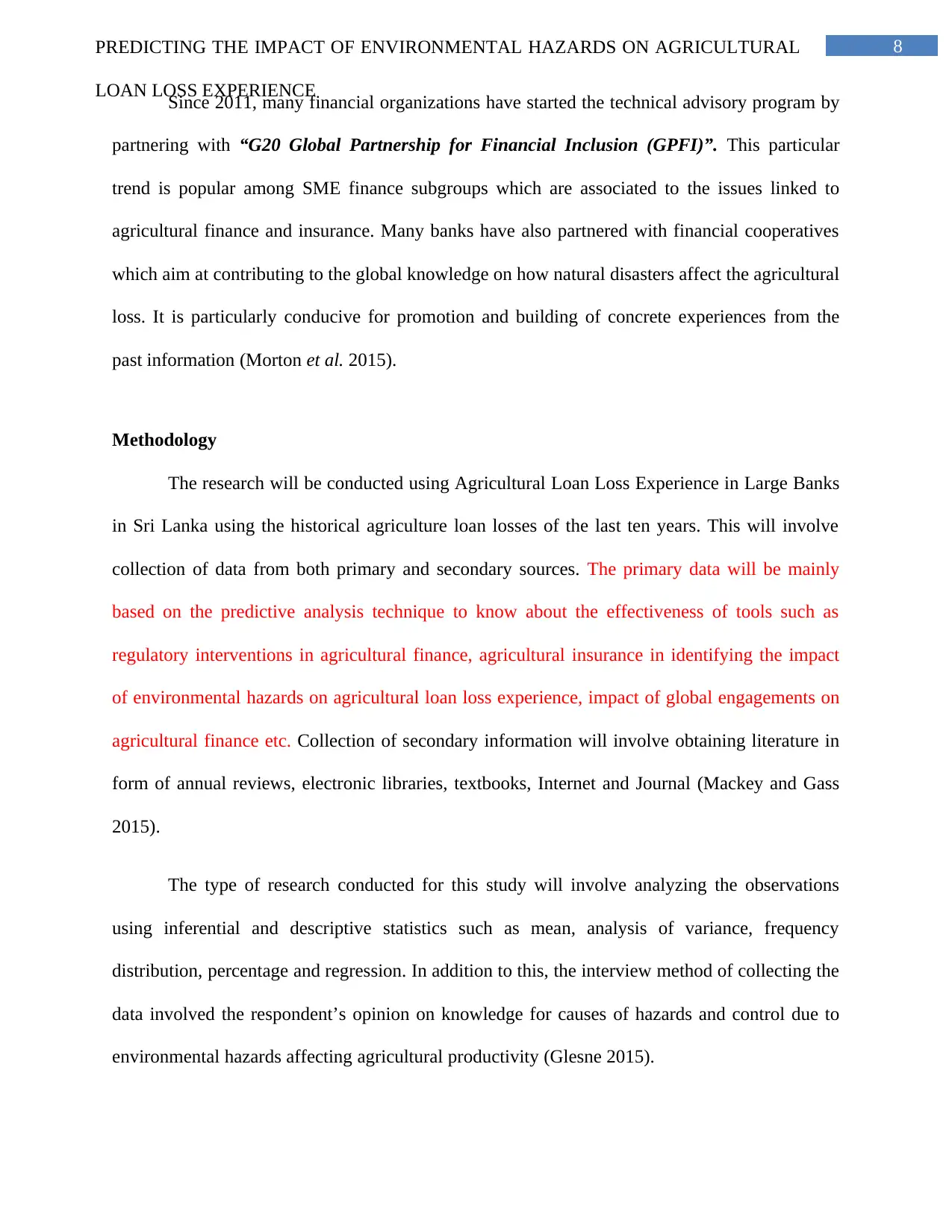
8PREDICTING THE IMPACT OF ENVIRONMENTAL HAZARDS ON AGRICULTURAL
LOAN LOSS EXPERIENCE
Since 2011, many financial organizations have started the technical advisory program by
partnering with “G20 Global Partnership for Financial Inclusion (GPFI)”. This particular
trend is popular among SME finance subgroups which are associated to the issues linked to
agricultural finance and insurance. Many banks have also partnered with financial cooperatives
which aim at contributing to the global knowledge on how natural disasters affect the agricultural
loss. It is particularly conducive for promotion and building of concrete experiences from the
past information (Morton et al. 2015).
Methodology
The research will be conducted using Agricultural Loan Loss Experience in Large Banks
in Sri Lanka using the historical agriculture loan losses of the last ten years. This will involve
collection of data from both primary and secondary sources. The primary data will be mainly
based on the predictive analysis technique to know about the effectiveness of tools such as
regulatory interventions in agricultural finance, agricultural insurance in identifying the impact
of environmental hazards on agricultural loan loss experience, impact of global engagements on
agricultural finance etc. Collection of secondary information will involve obtaining literature in
form of annual reviews, electronic libraries, textbooks, Internet and Journal (Mackey and Gass
2015).
The type of research conducted for this study will involve analyzing the observations
using inferential and descriptive statistics such as mean, analysis of variance, frequency
distribution, percentage and regression. In addition to this, the interview method of collecting the
data involved the respondent’s opinion on knowledge for causes of hazards and control due to
environmental hazards affecting agricultural productivity (Glesne 2015).
LOAN LOSS EXPERIENCE
Since 2011, many financial organizations have started the technical advisory program by
partnering with “G20 Global Partnership for Financial Inclusion (GPFI)”. This particular
trend is popular among SME finance subgroups which are associated to the issues linked to
agricultural finance and insurance. Many banks have also partnered with financial cooperatives
which aim at contributing to the global knowledge on how natural disasters affect the agricultural
loss. It is particularly conducive for promotion and building of concrete experiences from the
past information (Morton et al. 2015).
Methodology
The research will be conducted using Agricultural Loan Loss Experience in Large Banks
in Sri Lanka using the historical agriculture loan losses of the last ten years. This will involve
collection of data from both primary and secondary sources. The primary data will be mainly
based on the predictive analysis technique to know about the effectiveness of tools such as
regulatory interventions in agricultural finance, agricultural insurance in identifying the impact
of environmental hazards on agricultural loan loss experience, impact of global engagements on
agricultural finance etc. Collection of secondary information will involve obtaining literature in
form of annual reviews, electronic libraries, textbooks, Internet and Journal (Mackey and Gass
2015).
The type of research conducted for this study will involve analyzing the observations
using inferential and descriptive statistics such as mean, analysis of variance, frequency
distribution, percentage and regression. In addition to this, the interview method of collecting the
data involved the respondent’s opinion on knowledge for causes of hazards and control due to
environmental hazards affecting agricultural productivity (Glesne 2015).
⊘ This is a preview!⊘
Do you want full access?
Subscribe today to unlock all pages.

Trusted by 1+ million students worldwide
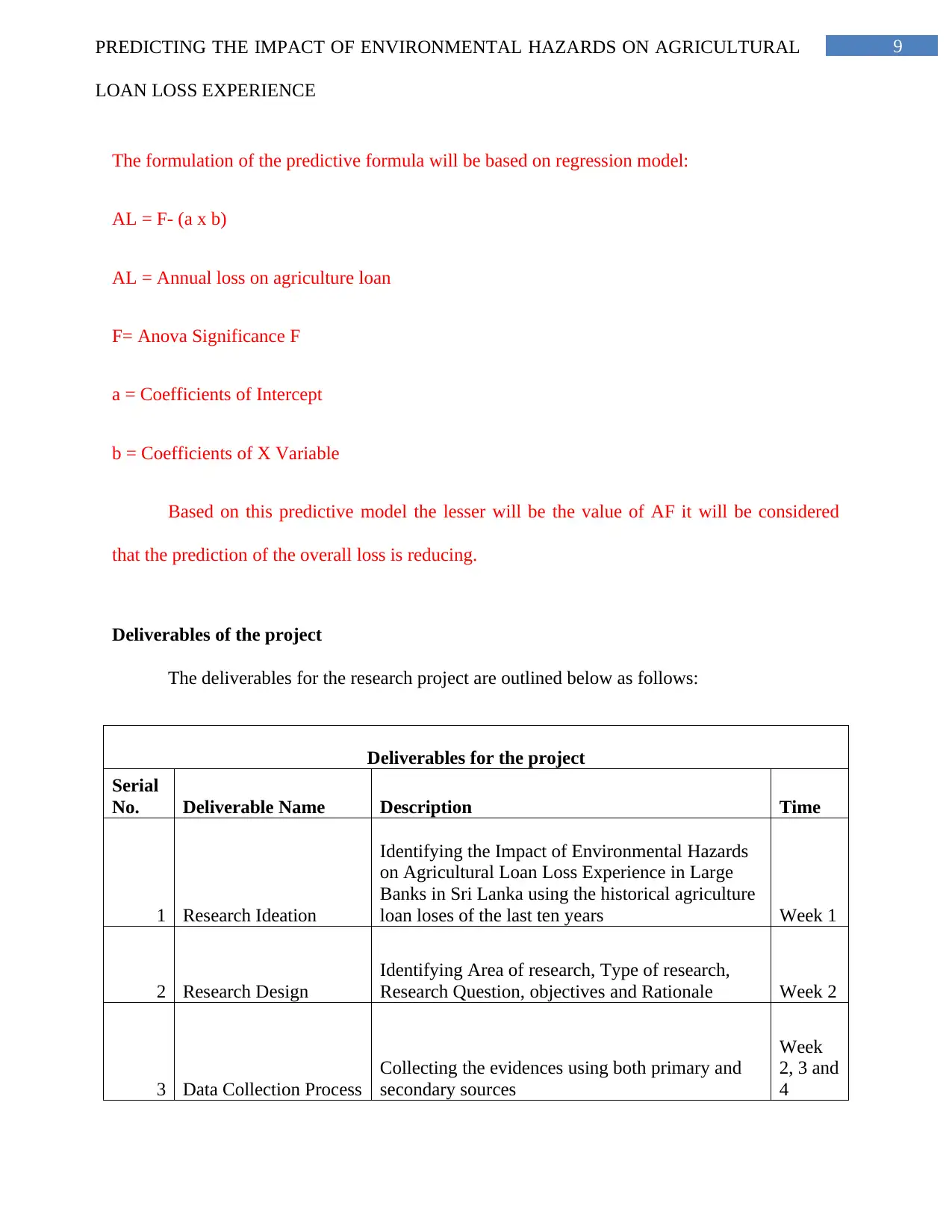
9PREDICTING THE IMPACT OF ENVIRONMENTAL HAZARDS ON AGRICULTURAL
LOAN LOSS EXPERIENCE
The formulation of the predictive formula will be based on regression model:
AL = F- (a x b)
AL = Annual loss on agriculture loan
F= Anova Significance F
a = Coefficients of Intercept
b = Coefficients of X Variable
Based on this predictive model the lesser will be the value of AF it will be considered
that the prediction of the overall loss is reducing.
Deliverables of the project
The deliverables for the research project are outlined below as follows:
Deliverables for the project
Serial
No. Deliverable Name Description Time
1 Research Ideation
Identifying the Impact of Environmental Hazards
on Agricultural Loan Loss Experience in Large
Banks in Sri Lanka using the historical agriculture
loan loses of the last ten years Week 1
2 Research Design
Identifying Area of research, Type of research,
Research Question, objectives and Rationale Week 2
3 Data Collection Process
Collecting the evidences using both primary and
secondary sources
Week
2, 3 and
4
LOAN LOSS EXPERIENCE
The formulation of the predictive formula will be based on regression model:
AL = F- (a x b)
AL = Annual loss on agriculture loan
F= Anova Significance F
a = Coefficients of Intercept
b = Coefficients of X Variable
Based on this predictive model the lesser will be the value of AF it will be considered
that the prediction of the overall loss is reducing.
Deliverables of the project
The deliverables for the research project are outlined below as follows:
Deliverables for the project
Serial
No. Deliverable Name Description Time
1 Research Ideation
Identifying the Impact of Environmental Hazards
on Agricultural Loan Loss Experience in Large
Banks in Sri Lanka using the historical agriculture
loan loses of the last ten years Week 1
2 Research Design
Identifying Area of research, Type of research,
Research Question, objectives and Rationale Week 2
3 Data Collection Process
Collecting the evidences using both primary and
secondary sources
Week
2, 3 and
4
Paraphrase This Document
Need a fresh take? Get an instant paraphrase of this document with our AI Paraphraser
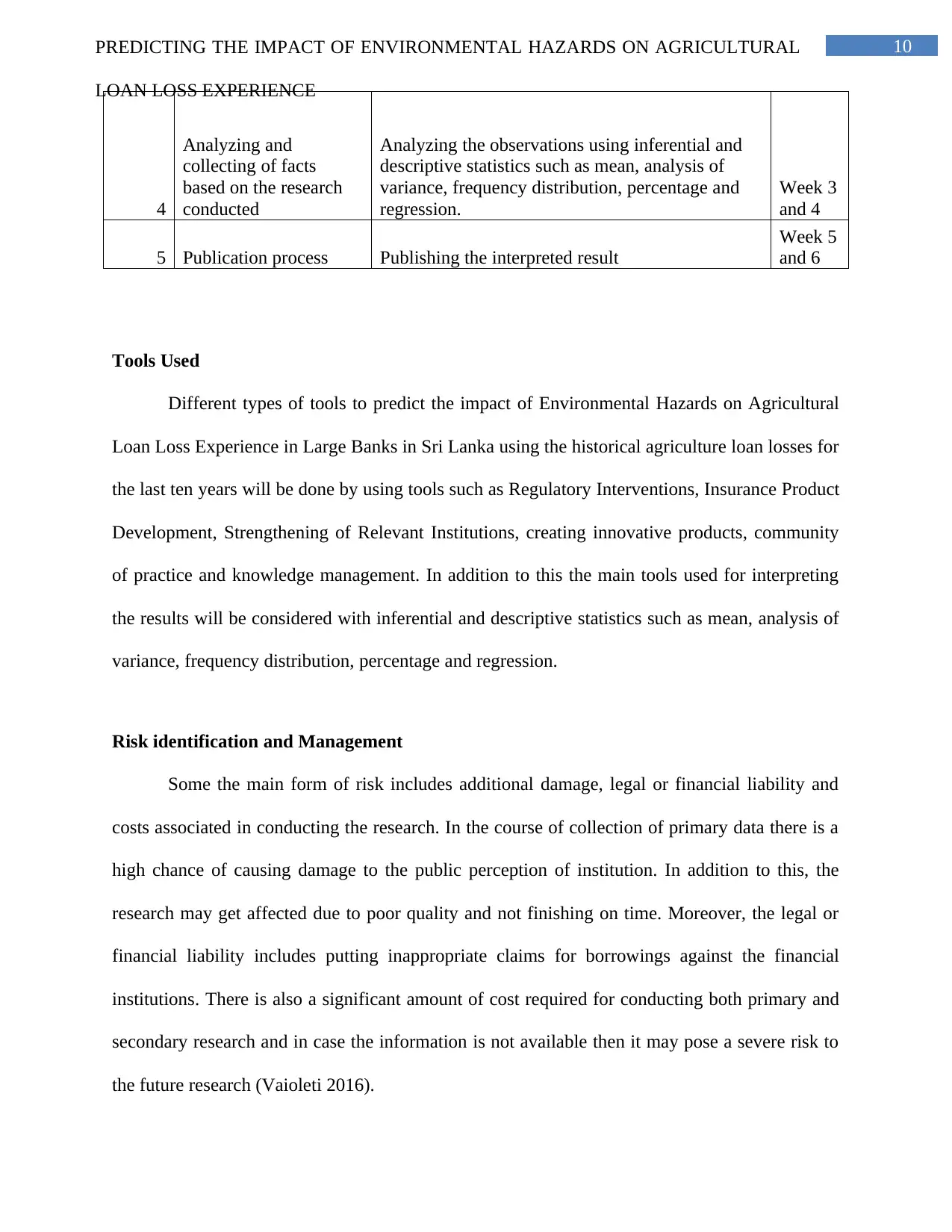
10PREDICTING THE IMPACT OF ENVIRONMENTAL HAZARDS ON AGRICULTURAL
LOAN LOSS EXPERIENCE
4
Analyzing and
collecting of facts
based on the research
conducted
Analyzing the observations using inferential and
descriptive statistics such as mean, analysis of
variance, frequency distribution, percentage and
regression.
Week 3
and 4
5 Publication process Publishing the interpreted result
Week 5
and 6
Tools Used
Different types of tools to predict the impact of Environmental Hazards on Agricultural
Loan Loss Experience in Large Banks in Sri Lanka using the historical agriculture loan losses for
the last ten years will be done by using tools such as Regulatory Interventions, Insurance Product
Development, Strengthening of Relevant Institutions, creating innovative products, community
of practice and knowledge management. In addition to this the main tools used for interpreting
the results will be considered with inferential and descriptive statistics such as mean, analysis of
variance, frequency distribution, percentage and regression.
Risk identification and Management
Some the main form of risk includes additional damage, legal or financial liability and
costs associated in conducting the research. In the course of collection of primary data there is a
high chance of causing damage to the public perception of institution. In addition to this, the
research may get affected due to poor quality and not finishing on time. Moreover, the legal or
financial liability includes putting inappropriate claims for borrowings against the financial
institutions. There is also a significant amount of cost required for conducting both primary and
secondary research and in case the information is not available then it may pose a severe risk to
the future research (Vaioleti 2016).
LOAN LOSS EXPERIENCE
4
Analyzing and
collecting of facts
based on the research
conducted
Analyzing the observations using inferential and
descriptive statistics such as mean, analysis of
variance, frequency distribution, percentage and
regression.
Week 3
and 4
5 Publication process Publishing the interpreted result
Week 5
and 6
Tools Used
Different types of tools to predict the impact of Environmental Hazards on Agricultural
Loan Loss Experience in Large Banks in Sri Lanka using the historical agriculture loan losses for
the last ten years will be done by using tools such as Regulatory Interventions, Insurance Product
Development, Strengthening of Relevant Institutions, creating innovative products, community
of practice and knowledge management. In addition to this the main tools used for interpreting
the results will be considered with inferential and descriptive statistics such as mean, analysis of
variance, frequency distribution, percentage and regression.
Risk identification and Management
Some the main form of risk includes additional damage, legal or financial liability and
costs associated in conducting the research. In the course of collection of primary data there is a
high chance of causing damage to the public perception of institution. In addition to this, the
research may get affected due to poor quality and not finishing on time. Moreover, the legal or
financial liability includes putting inappropriate claims for borrowings against the financial
institutions. There is also a significant amount of cost required for conducting both primary and
secondary research and in case the information is not available then it may pose a severe risk to
the future research (Vaioleti 2016).
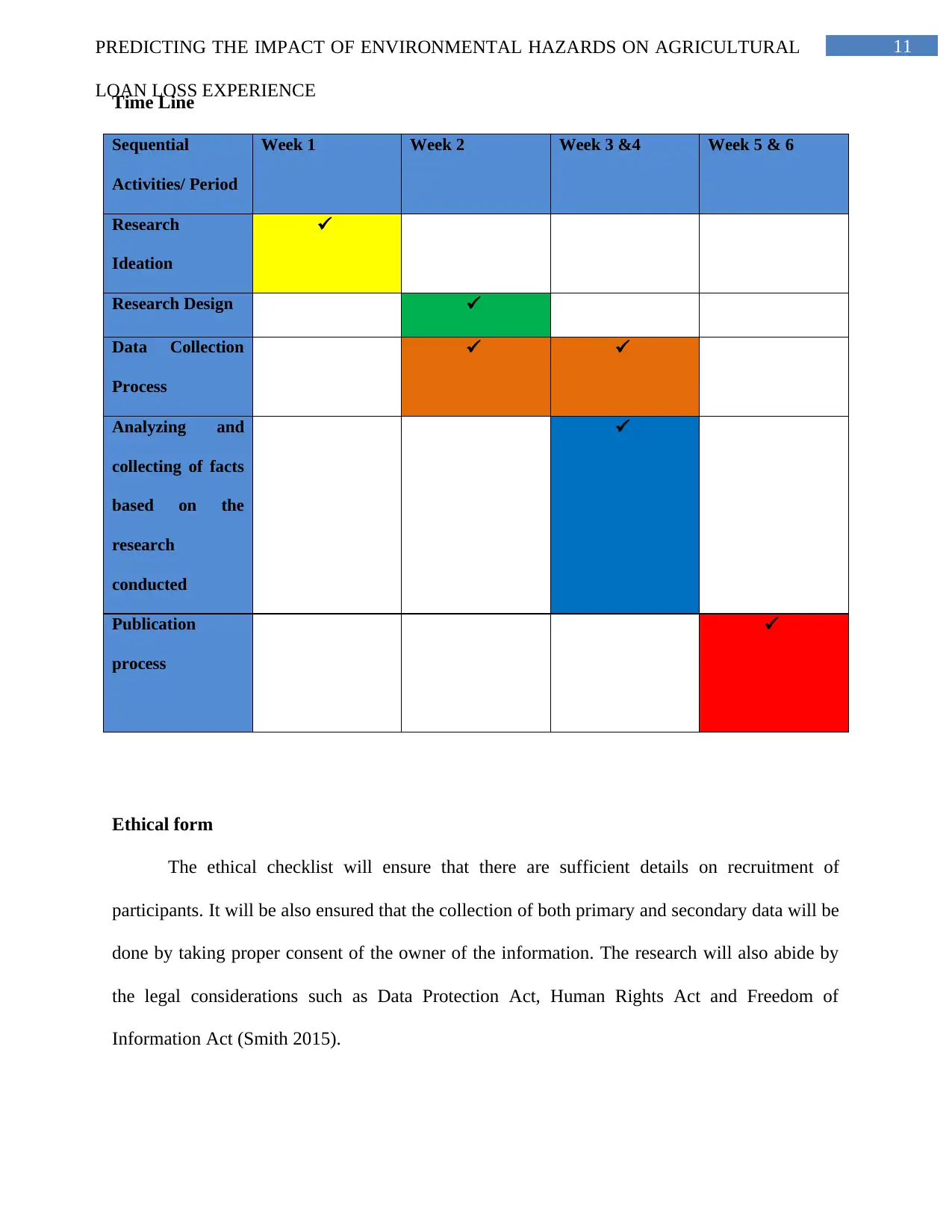
11PREDICTING THE IMPACT OF ENVIRONMENTAL HAZARDS ON AGRICULTURAL
LOAN LOSS EXPERIENCE
Time Line
Sequential
Activities/ Period
Week 1 Week 2 Week 3 &4 Week 5 & 6
Research
Ideation
Research Design
Data Collection
Process
Analyzing and
collecting of facts
based on the
research
conducted
Publication
process
Ethical form
The ethical checklist will ensure that there are sufficient details on recruitment of
participants. It will be also ensured that the collection of both primary and secondary data will be
done by taking proper consent of the owner of the information. The research will also abide by
the legal considerations such as Data Protection Act, Human Rights Act and Freedom of
Information Act (Smith 2015).
LOAN LOSS EXPERIENCE
Time Line
Sequential
Activities/ Period
Week 1 Week 2 Week 3 &4 Week 5 & 6
Research
Ideation
Research Design
Data Collection
Process
Analyzing and
collecting of facts
based on the
research
conducted
Publication
process
Ethical form
The ethical checklist will ensure that there are sufficient details on recruitment of
participants. It will be also ensured that the collection of both primary and secondary data will be
done by taking proper consent of the owner of the information. The research will also abide by
the legal considerations such as Data Protection Act, Human Rights Act and Freedom of
Information Act (Smith 2015).
⊘ This is a preview!⊘
Do you want full access?
Subscribe today to unlock all pages.

Trusted by 1+ million students worldwide
1 out of 15
Your All-in-One AI-Powered Toolkit for Academic Success.
+13062052269
info@desklib.com
Available 24*7 on WhatsApp / Email
![[object Object]](/_next/static/media/star-bottom.7253800d.svg)
Unlock your academic potential
Copyright © 2020–2025 A2Z Services. All Rights Reserved. Developed and managed by ZUCOL.


